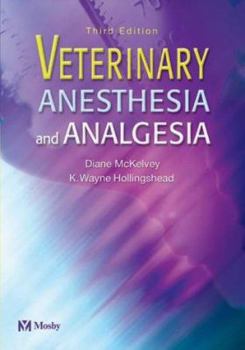Veterinary Anesthesia and Analgesia
Select Format
Select Condition 
Book Overview
This book is a concise guide to the principles of anesthesia administration in animals. Users cite readability, organization, "essential" coverage, illustration program, currency, illustrations, appropriateness for veterinary technicians, pedagogical features, and step-by-step illustrated procedure boxes among its many strengths.
This practical resource prepares veterinary technicians to administer anesthesia. Information is given on preanesthetic preparation of the patient, induction procedures, monitoring animals' vital signs during the anesthetic period, and postoperative care. It includes discussions of actions and side effects of anesthetic agents; the physiology of respiration, heart rate, and blood pressure; emergency response; anesthetic equipment; and specialized techniques, such as local anesthesia, postoperative analgesia, and the use of muscle-paralyzing agents and ventilators.
This is the only book on veterinary anesthesia written explicitly for technicians, providing detailed, essential information that technicians must know.Concepts are presented in a clear, readable, well-organized format with key points, learning objectives, and review questions.Health and Safety issues surrounding anesthesia are discussed and safety procedures are outlined, as required by OSHA.Emphasis is placed on appropriate response to emergencies, and provisions of the effective pain control.Effective learning features such as objectives, key points, and review questions, help reinforce key information.All drugs and procedures included throughout the book are fully are up-to-date.Clear, useful illustrations and tables highlight important facts and concepts.A solid balance of theory and application takes the reader from learning to real-world practice.Step-by-step Procedures boxes clarify the technician's role in anesthesia delivery.Notes throughout the text highlight important precautions and/or emergency interventions.A section on client education focuses on compliance with NPO instructions and age-related complications of anesthesia.New information is provided on the use of NSAID (nonsteroidal antiinflammatory drugs - aspirin, ibuprofen) and opioid analgesics for pain control - now accepted as an indispensable aspect of anesthesia.Expanded discussions of sophisticated monitoring instruments and equipment address capnography, pulse oximetry, blood pressure measurement, and electrocardiology.An expanded section on anesthestic agents includes newer drugs such as medetomidine (Domitor) seroflurane, and analgesics such as carprofen (Rimadyl) and meloxicam (Metacam).The new title, previously published as Small Animal Anesthesia and Analgesia, reflects this edition's expanded scope and inclusion of other species.A new chapter on large animal anesthesia focuses predominantly on horses and cows.A new chapter on exotics covers various exotic pets, with an emphasis on pocket pets and birds.New line drawings and photographs of new equipment and techniques for delivery bring the book up to date with advances in the field.





